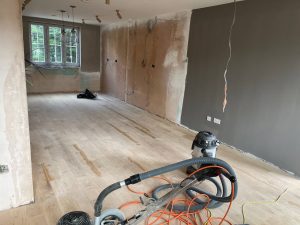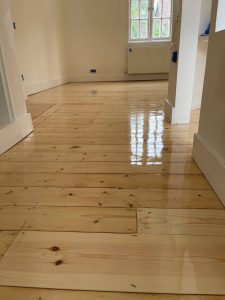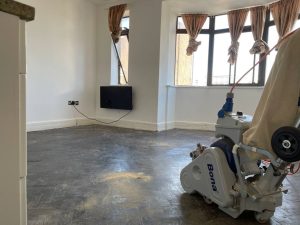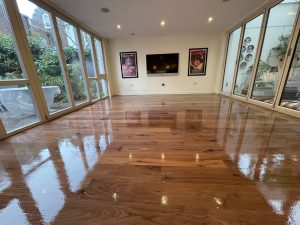
Floor sanding is a popular method for rejuvenating wooden floors, but it often comes with many questions. If you’re considering floor sanding for your London home, this comprehensive FAQ guide will answer all your pressing queries, helping you make an informed decision.
- What is Floor Sanding?
Answer: Floor sanding is the process of removing the top surface of a wooden floor using abrasive materials. This technique smooths out imperfections, removes old finishes, and prepares the floor for a new stain or sealant, restoring its natural beauty and durability.
- Why Should I Sand My Floors?
Answer: Sanding your floors can:
- Restore their original beauty by removing scratches and stains.
- Increase your home’s value by improving the aesthetics.
- Prolong the lifespan of your floors by eliminating damaged surfaces.
- Improve safety by removing splinters and uneven surfaces.
- How Often Should I Sand My Floors?
Answer: The frequency of floor sanding depends on the amount of traffic your floors endure. Generally, floors should be sanded every 7-10 years in high-traffic areas, and every 10-15 years in low-traffic areas.
- Can I Sand My Floors Myself?
Answer: While DIY floor sanding is possible, it requires skill and the right equipment. Hiring a professional ensures a high-quality finish and avoids potential damage to your floors. If you choose to do it yourself, ensure you have the proper tools and follow a step-by-step guide.
- What Equipment is Needed for Floor Sanding?

Answer: For professional results, you’ll need:
- A drum sander for large areas.
- An edge sander for corners and edges.
- Sandpaper of various grits (coarse, medium, and fine).
- A vacuum cleaner to remove dust.
- Safety gear, including a mask, goggles, and ear protection.
- How Long Does the Sanding Process Take?
Answer: The duration depends on the size of the area and the condition of the floors. Generally, sanding a room can take 1-2 days, including preparation and cleanup. Adding staining or sealing can extend the process by another 1-2 days, depending on drying times.
- What Finishes Can Be Applied After Sanding?
Answer: Several finishes can be applied, including:
- Water-Based Polyurethane: Quick-drying and clear.
- Oil-Based Polyurethane: Durable with a warm hue.
- Hard Wax Oil: Natural appearance and easy maintenance.
- Acid-Cured Finish: Extremely durable and quick-drying.
- Penetrating Oil Sealer: Deep penetration with a natural look.
- How Do I Maintain My Sanded Floors?
Answer: To keep your floors looking their best:
- Sweep or vacuum regularly to remove dirt and debris.
- Use a damp mop with a pH-neutral cleaner.
- Place mats at entryways to reduce tracked-in dirt.
- Use felt pads under furniture legs to prevent scratches.
- Reapply finish as needed, depending on wear and tear.
- Will Sanding Remove Deep Scratches and Stains?
Answer: Yes, floor sanding can effectively remove deep scratches and stains by eliminating the top layer of the wood. For very deep gouges, additional filling and sanding may be required.
- Is Floor Sanding Messy?
Answer: Sanding generates a significant amount of dust, but modern equipment with dust collection systems can minimize the mess. Proper preparation, including sealing off other areas of the house, can also help contain dust.
- Can All Types of Wood Floors Be Sanded?

Answer: Most solid wood floors and some engineered wood floors can be sanded. However, floors with a very thin veneer layer or those in poor condition may not be suitable for sanding. It’s best to consult a professional to assess your specific flooring.
- What Should I Do Before the Professionals Arrive?
Answer: Before the sanding professionals arrive:
- Clear the room of all furniture and rugs.
- Remove any nails or staples from the floor.
- Ensure the room is well-ventilated.
- Discuss any specific concerns or desired outcomes with the professionals.
Conclusion
Understanding the floor sanding process and its benefits can help you make the best decision for maintaining and enhancing your wooden floors. Whether you choose to tackle the project yourself or hire professionals, properly sanded and finished floors can significantly elevate the look and feel of your London home. If you have more questions or need professional assistance, don’t hesitate to contact a reputable floor sanding service. Your beautiful, revitalized floors await.









How to Choose the Right Sandpaper for Floor Sanding
How to Choose the Right Sandpaper for Floor Sanding Ensure a Smooth and Professional[Read more...]
Why Professional Floor Sanding is Worth the Investment
Why Professional Floor Sanding is Worth the Investment Discover the Benefits of Hiring Experts[Read more...]
Floor Board Fitting
Installing, Fitting, sanding and finishing different types of flooring takes a lot of work. when[Read more...]
Sep
Parquet Flooring
With parqueting bring nature into your home. Parquet flooring is different than regular wood flooring,[Read more...]
The Best Floor Sanding Practices for Allergy Sufferers
The Best Floor Sanding Practices for Allergy Sufferers For allergy sufferers, maintaining a clean[Read more...]
The Importance of Professional Inspections Before Sanding
The Importance of Professional Inspections Before Sanding Ensure your London home is prepared for[Read more...]
Polishing the floor in london
[Read more...]
How to Identify and Repair Water Damage Before Sanding
How to Identify and Repair Water Damage Before Sanding Ensure your London home’s floors[Read more...]
Floor sanding and renovation and installation services in London
Revitalize Your Floors with Expert Sanding Services in London London, the bustling capital of the[Read more...]
How to Create a Vintage Look with Floor Sanding and Finishing
How to Create a Vintage Look with Floor Sanding and Finishing Creating a vintage[Read more...]